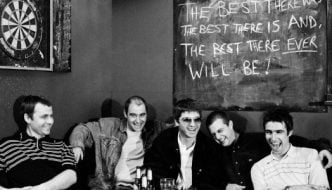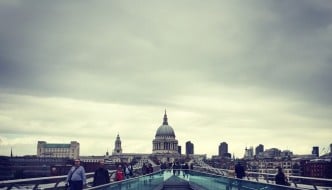‘The pictorial chronicler of the global economy’: Andreas Gursky @ The Hayward Gallery
March 11, 2018

Les Mées, 2016 C-Print 220.9 x 367.2 x 6.2 cm © Andreas Gursky/DACS, 2017 Courtesy: Sprüth Magers
The introduction of global markets, society’s inherent drive for commerce, constantly increasing financial returns to scale – these are the economic factors which underpin modernity’s race to get BIG. This race is fuelled by the capitalist’s urge to out-scale, out-produce, and out-span all competition, with the aim of monopolising the market.
ANDREAS GURSKY – the name that has dominated this race to supersize throughout most of photography’s digital era. The modern photographic giant has an undeniable capacity to wow, if not but through sheer scale and enormity alone. Gursky’s especial ability to blow photographs up to an unprecedented magnitude provides the images with a heady amount of detail and an ostensible importance. They command 2-D spaces with their ludicrous depths of detail, and in doing so demand the viewers’ attention. The scale of Gursky’s work is undoubtedly monumental, and at times slightly overwhelming. The immersive nature of the images examines all preconceptions about relationships between photography, reality, and (to a certain extent) ‘truth’ within an image. This examination pushes the vocabulary and parameters of photography as an artistic medium.
The epic volume of Gursky’s work has to be conflated with the artist’s unassailable eye for order and synchronicity in composition. A recurring motif throughout the UK’s first major retrospective of the highly celebrated German photographer is the strife to provide formal patterns to humanity’s existence within surrounding environments. The retrospective is – in the artist’s own words – a pictorial investigation into ‘the ways in which the world is constituted’. The newly refurbished Hayward Gallery plays host to this pictorial investigation, documenting Gursky’s work in a largely chronological order. The linear narrative of this curatorial has the effect of highlighting society’s transition away from predominantly existing within natural environments, and towards large influxes to city living. The viewer is invited to contemplate society’s changing relationship with the natural world, and the profound effect of the global market on humanity’s everyday existence.
The first room of the retrospective is largely constituted of work from the 1980’s. What is to become Gursky’s signature style – a distant perspective and a highly saturated colour palette – is seen for the first time. In this early part of the German’s highly acclaimed career, small forms of human intervention are captured within natural environments. The encompassing viewpoint used by Gursky explores relationships of control, and modification between human inhabitants and their prevailing natural spaces. A wide perspective provides an inevitable anonymity to the figures, and the viewer is never directly confronted by identities. This turns the focus of the work away from individuality, and towards a macro-level exploration of social interaction with natural environments. Individual identity becomes secondary to the nature of the image, and the primary intention explores wider social practices of leisure and recreation.
The 1990’s marked a seismic shift in the nature of Gursky’s work, as the photographer turned the majority of his attention towards brutal and industrial infrastructure. The German was adapting to his surrounding socio-economic climates, by beginning to astutely capture the expansion of manufacturing capabilities and man-made environments. This expansion was a necessary result of society’s move towards an unswerving pursuit of economic growth. This unswerving pursuit effected a subsequent dilapidation of parts of the natural environment. Gursky renders this environmental transition through a move towards the realms of the digital, leaving behind his father’s ‘old and cumbersome’ Linhof film camera. This period signifies an important shift in the photographer’s career as it begins to open up the possibilities and wonders of digital post-production.
“Since 1992 I have consciously made use of the possibilities offered by electronic picture procession, so as to emphasise formal elements that will enhance the picture, or… to apply a picture concept that in real terms of perspective would be impossible to realise.”
Part of the approbation surrounding the German’s illustrious career can be pinned down to his ability to stay at the forefront of technological possibilities. This is perfectly illustrated by Rhine II (1999), a photograph which appears to be (for any rational individual applying intensive reasoning) an impossibly straight and symmetric depiction of the Rhine river. Quite possibly Gursky’s most recognisable image, it fetched an eye-watering £2.7 million at Christie’s auction in New York, setting a new world record for a photograph. At the time of its creation, the image was almost paradoxically nuanced, and completely pioneering. The ability to remove people and power-plants, to reveal the minimalist, highly manufactured, and semi-abstracted configuration of horizontal bands created a futuristic formal coherence. The brilliance of the work lies in its seemingly abstracted expressionism – from a distance the photograph could easily been mistaken to be by the likes of a Rothko.
Moving through the retrospective, the viewer begins to witness Gursky truly solidify his style. Later rooms begin to exhibit a continuity in scale and stylistic formality, suggesting that the artist has found a confidence in his own photographic and editorial bravura. This confidence allows the German to jump between a highly eclectic range of subject matter, whilst managing to sustain a distinctive viewpoint and style. The retrospective travels between a Wall Street trading floor, a North Korean gymnastic meets, a Dortmund rave, an Amazon warehouse, the Bahrain Grand Prix, and parliamentary Germany (and this list doesn’t even do the artist’s eclecticism justice). I don’t think there can be an accolade of photographic skill much higher than this stylistic transferability; every photograph in the exhibition manages to keep a Gurksy-esque cohesion. Part of this cohesion can be put down to the print and framing used for the Hayward’s retrospective. The images are directly and permanently fused onto the acrylic sheet which frames them, using a pioneering process called diasec.

Utah (2017) Ink jet print, Diasec 225x 457 x 6.4cm © Andreas Gursky/DACS, 2017 Courtesy: Sprüth Magers

Amazon, 2016 Inkjet-Print 207 x 407 x 6.2 cm © Andreas Gursky/DACS, 2017 Courtesy: Sprüth Magers
The Gursky exhibition closes on 22nd April. I highly recommend visiting the Hayward Gallery to witness Gursky test the frontiers of photographic capabilities. For more information please see the Hayward Gallery’s website.




Comments